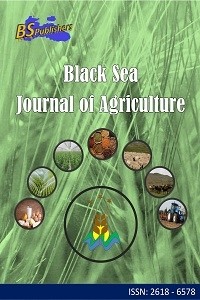
Black Sea Journal of Agriculture
Yazarlar: ["İremnaz GÜLMÜŞ", "Emre Burcu ÖZKARAOVA"]
Konular:-
DOI:10.47115/bsagriculture.1126352
Anahtar Kelimeler:Artificial wetland,Agricultural drainage water,Residence time,Ammonium and nitrate
Özet: Harmful substances in the wastewater negatively affect the ecological balance by reducing the dissolved oxygen concentration. High phosphorus and nitrogen compounds discharged into surface water resources may cause to eutrophication, due to increased algal growth. In this study, Elodea densa (Egeria), Lemna minor (Duckweed), Micranthemum micranthemoides (Micra), Pistia (Water Lettuce), Ceratophyllum demersum (Foxtail) plants were investigated for the removal of nitrate and ammonium from rice field drainage water. Synthetic drainage water was prepared to rely on the literature and real rice field drainage water composition from the Samsun Bafra region. Artificial wetland studies were carried out as individual systems in order to understand the treatment ability of each plant and as a combined system in batch and continuous flow mode. pH, electrical conductivity, dissolved oxygen, nitrate, and ammonium values were measured periodically. Results of the individual plant wetland system represented that the wetland plant Elodea densa revealed the highest nitrate removal efficiency (77%) at the end of 1 day, followed by Pistia (76%). It was observed that the treatment efficiency increased with increasing hydraulic retention time. In the combined system, the nitrate removal efficiency was 40%, while the ammonium removal efficiency was 51% at the end of the first day. It was concluded that the wetland plants successfully reduced the ammonium and nitrate content of the drainage water and showed resistance to the drainage water with high salinity. In the wetland experiments carried out under continuous flow mode, ammonium was reduced from 0.80 mg/L to 0.10 mg/L, while nitrate was reduced from 1.90 mg/L to 1.40 mg/L, yielding approximately 90% and 30% at the end of the 16th day. Studies have in general revealed the importance of plant type as well as residence time.